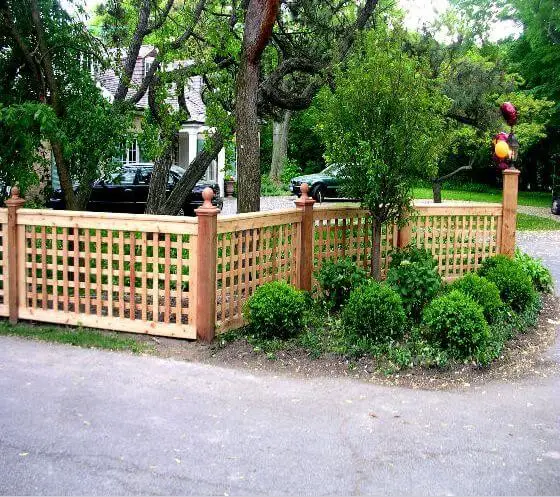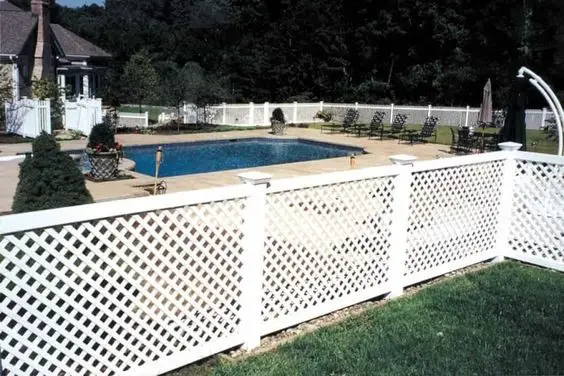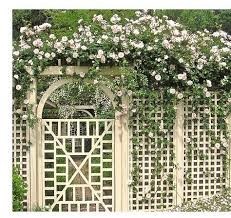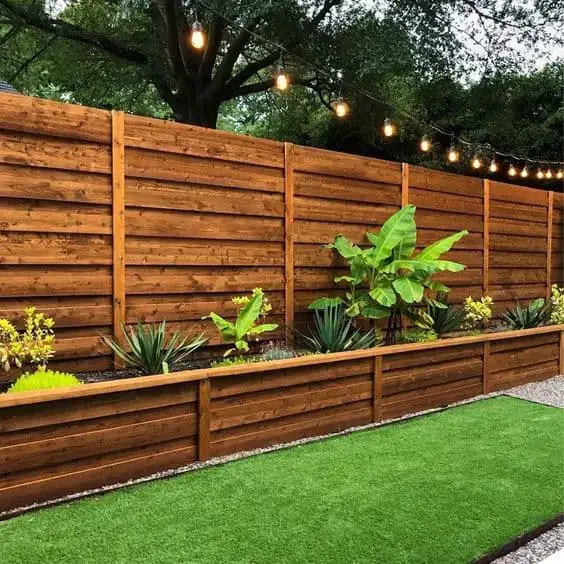23+ Best Lattice Fence Ideas And Designs For Your Garden And Backyard
While simplicity and elegance are certainly attractive qualities, homeowners are increasingly drawn to lattice fencing due to its versatility, ease of installation, and cost-effectiveness. This type of fencing can be used for various purposes, including creating privacy barriers, outlining spaces, or adding decorative flair. If you’re considering a lattice fence for your garden or patio, here are some ideas to get you started.
What is a lattice fence?
What sets lattice fences apart from other types of fencing is their distinctive diagonal slats and crisscross pattern. This unique design makes them a popular choice for incorporating an oriental flair into gardens, spas, and patios. Additionally, they can be used to create cozy enclosures or dividers within the home. One of the biggest advantages of lattice fences is their affordability, making them an attractive option for those on a budget.
Furthermore, they are known for being durable and versatile, making them a practical choice for homeowners who want a low-maintenance yet effective way to define outdoor spaces.
How much does a lattice fence cost?
When it comes to calculating the cost of a lattice fence, several factors come into play. The primary consideration is the quality grade of the material used in its construction. Lattice fences are typically priced per foot, and the cost can vary significantly depending on the type of material chosen. At the lower end of the spectrum, plastic lattice fences start at around $2 to $4 per foot, making them an affordable option for many homeowners.
For those seeking a more durable and aesthetically pleasing solution, medium-grade or cheap wood lattice fences can be found in the $2.50 to $5 range per foot. However, for those looking to invest in a high-quality, premium product, quality wood lattice fences can cost anywhere from $8 to $25 per foot.
How do you make a simple lattice fence?
To create your own simple lattice fence, start by preparing the necessary materials. These include: tape measure, post-hole digger, string level, circular and power miter saw, clamps, hammer, nails and screws, screw gun, 4×4 pressure-treated vinyl/wood posts, 4×8 pressure-treated lattice panel, and a 1x8x8 pressure treated vinyl/wood board. With these materials in hand, follow the steps below to construct your lattice fence.
Step 1: Begin by creating the lattice screen itself.
To do this, make a 4×8 wood/vinyl board frame using nails, screws, saw, and hammer. You can adjust the dimensions to suit your desired size.
Step 2: If you’re using the lattice fence as a screen or divider only, you won’t need to dig post holes. However, if it’s meant for anything else, dig two post holes that are 8 inches apart. Temporarily stabilize the posts with scrap wood and use them as temporary braces.
Step 3: Position the posts in their respective holes, ensuring they’re aligned properly. Permanently secure the posts into the ground, then pour concrete mix to set them firmly in place. Allow the mixture to cure overnight before proceeding.
Step 4: It’s time to attach the lattice panels. If you’re taking a DIY approach, cut horizontal and diagonal wood strips to 4×8 ft as well. Then, nail the panels one by one to form medium-sized squares on the wood board, screwing from top to bottom.
Step 5: Make any final adjustments, checking for edges that may need trimming. If desired, stain the wood to enhance its appearance. Pressure-treated wood will naturally develop a gray color over time, so staining might not be necessary in this case.
Pros and cons of lattice fence
When considering the installation of a lattice fence, it’s crucial to weigh the benefits against the drawbacks. By doing so, you’ll avoid costly mistakes and ensure that you select the most suitable fencing option for your needs. To guide your decision-making process, let’s explore some key pros and cons of lattice fencing.
Pros
A versatile and budget-friendly addition to any outdoor space, this feature allows for effortless installation and integration with existing fencing. Its multi-faceted nature enables it to serve multiple purposes, including support for climbing plants and vines, while also providing a visually appealing outline for gardens or separating distinct plant beds.
Additionally, its rustic charm makes it an ideal accent piece for whimsical-themed gardens, stair railings, or as a standalone decorative element that can be adapted to various fence types.
Cons
Lattice fences, with their characteristic open design, aren’t the best choice for high-privacy fencing due to the inherent holes that allow for visibility. Moreover, there have been concerns about their durability, particularly in terms of resisting extreme stress and strain.
Furthermore, lattice fences can be more challenging to maintain compared to solid options, as they require regular inspections to detect signs of rot or mildew buildup, ensuring prompt attention is given before issues escalate.
23 lattice fence ideas for the garden and backyard
Privacy decorative lattice fence




When considering decorative lattice fences, we often think of semi-private designs with latticework screens topping off the perimeter of a house. However, there are also full-lattice privacy screens specifically designed for backyard decks or patios. These semi-private lattice perimeters serve as a stylish accent to modern design picket fences, effortlessly complementing wooden decks.
Similarly, vinyl panels can be used to create a clean, minimalist look that complements colonial-style homes with well-planned lighting. On the other hand, full-lattice deck privacy screens are ideal for large outdoor spaces, allowing individuals to feel more cozy and contained. Thinly slatted lattice fences can further enhance their effectiveness as privacy screens.
Rooftop/patio lattice fence



For a unique and functional solution to create a secluded oasis in your high-rise urban patio, consider incorporating climbers and vines into your perimeter fencing. This natural barrier can effectively enclose a green space within the urban jungle.
Alternatively, for a summer rooftop patio, a delicate slatted lattice fence would be an ideal choice.
Pair it with reclining chairs made from wood, an artificial grass patch, and other potted greens to create a serene retreat perfect for relaxation.
Inspired by telenovela or bayou settings, this design not only serves as a stylish accent to a wide home patio but also doubles as a safety feature for homes with small children or active pets.
Vine-free, high-gated lattice fence



A charming wooden fence, often featured on expansive countryside estates, can also add elegance to orchard gates. What’s intriguing is that its rustic charm belies the fact that it’s actually constructed from welded iron with a classic criss-cross lattice design. This unexpected combination of materials yields a unique and captivating visual effect.
This type of gate typically features an arched door, which adds a touch of sophistication and cultural flair reminiscent of Hispanic or oriental styles. The lattice top provides a beautiful accent that frames the entrance while maintaining a sense of enclosure.
For a more dramatic entrance, consider a full lattice gate with arches spanning the entire perimeter. This design creates a striking focal point in your garden or home’s entryway.
Thick slat lattice fence



Thick slat lattice fences are often used as versatile screening solutions in both residential and commercial settings. They can effectively separate different areas of a garden or poolside, while also adding a touch of elegance to large properties. For instance, a low-profile wooden thick slat lattice fence can bring a fresh yet homey charm to suburban homes, providing a striking contrast against towering trees and lush greenery.
Similarly, these screens can be cleverly arranged to create a lush backdrop for urban patios, offering a serene oasis in the midst of bustling city life. Whether you’re looking to add visual interest to small spaces or seeking a simple yet effective solution for screening off areas, thick slat lattice fences are an excellent choice.
Low lattice outline fence



Low lattice outline fences are utilized to create visual boundaries within gardens or to evoke the charm of countryside cottages, as depicted in the accompanying photographs. A simple yet effective design is showcased by a bamboo-made lattice fence, suitable for areas where strong winds do not prevail. This lightweight and rustic option is ideal for rural cottages, offering an effortless means of demarcating spaces.
In contrast, a wooden lattice fence is utilized to enclose flowering plants against a solid perimeter, creating a visually appealing display. The juxtaposition with the surrounding landscape adds depth and character to the overall design. A vinyl outline lattice fence, placed centrally within the garden, provides a stylish framework for showcasing annual plants as they bloom simultaneously, resulting in a kaleidoscope of colors contained within a harmonious structure.
Pool lattice fence



In poolside design, lattice structures serve multiple purposes – as screens, dividers, or perimeter fencing, much like their counterparts in patio fencing. For this particular setup, a screen lattice fence was skillfully integrated alongside an existing one, creating a stunning backdrop for the pool area that’s further enhanced by the inclusion of pool seats and a charming wooden pergola.
The clean vinyl lattice fence used here effectively encloses the entire house vicinity, including the pool area, while its neutral hue harmonizes seamlessly with the surrounding environment, imparting an air of sophistication reminiscent of Victorian-era elegance.
Alternatively, the addition of an iron panel featuring a small slat lattice fence can imbue a space with an industrial, private pool ambiance, courtesy of the deliberate inclusion of holes that allow for airflow and discreet views between neighbors.
Sloped lattice fence


Sloped lattice fences are characterized by their unique, uneven shapes and heights. This design element is often used to create visually interesting perimeters or as a way to add texture and depth to outdoor spaces through the use of lattice as dividers.
A great example of this style can be seen in a sloped wood lattice fence that stands out from surrounding plants, such as shrubs and trees. The addition of a wooden arch with lattice sides only adds to the natural, earthy vibe of the piece.
To complete the minimalist deck patio design, a thin slatted clean lattice vinyl fence is used. What sets this apart is its sloping style, which creates an interesting visual dynamic. Additionally, each lattice screen features different accents, including one with a full lattice and two others that have enough space for hanging baskets.
Vined lattice fence



While the lattice fence offers a more affordable option, it also serves as a versatile trellis for vines and climbers to thrive. For a homeowner seeking a multi-functional screen, divider, or fence, the lattice design is an ideal choice. Its utility extends beyond its functional purpose, as it can add whimsy to small garden patios by supporting arboreal plants or providing a structure for vines to climb.
This design also elevates the ambiance of sloped backyards by incorporating hanging basket plants and vines, evoking a sense of having one’s own vineyard. Moreover, the lattice fence can be repurposed as an eye-catching entrance feature for home walkways, imbuing a sense of fantasy with its clean, classic, and enchanting visual appeal. This design is particularly well-suited for countryside flower gardens or suburban homes boasting expansive outdoor spaces.
Frequently Asked Questions
Is a lattice fence cheaper?
While lattices may be the most affordable option when compared to wrought-iron, vinyl, aluminum, composite, and wood fencing, it’s essential to consider that there are other budget-friendly alternatives. Chain link, pallet, hog, and barbed wire fencing options, as well as electric fencing solutions, can also provide an economical solution for homeowners seeking to enhance their property’s perimeter.
Is wood or vinyl lattice better?
When deciding between wood and vinyl lattice, it’s a challenge to pinpoint the better option. Both have their unique advantages that can sway your decision. However, if you consider the flexibility of color options, wood lattice may take the lead. Not only can it be stained to achieve a natural look, but it also serves as an effective trellis and enhances the fragrance of flowers. Additionally, wood lattice is often more budget-friendly for outdoor fencing compared to vinyl.
Nevertheless, vinyl’s extensive color palette and low-maintenance requirements make it an attractive choice. Its resistance to rotting and mildew means less upkeep, while its production process prioritizes recycling used plastics, making it a more eco-friendly option.
Conclusion
In its own right, lattice fencing offers a harmonious blend of aesthetic appeal and functional value. Whether you’re looking to accentuate a large or secluded area, it can be an excellent choice for homeowners seeking to add visual interest without sacrificing practicality. While no material is perfect, the benefits of lattice fencing far outweigh its limitations, making it an increasingly popular option among homeowners.
We hope that our discussion has provided inspiration and guidance as you consider incorporating this style into your outdoor space.
Related Posts
When it comes to your farm business, selecting the right equipment is crucial for productivity and profitability. Similarly, protecting your home with a fence is vital for security and privacy. Meanwhile, understanding gratuity etiquette when hiring driveway sealers can make a big difference in how you’re treated as a customer. If you’re looking for a career change, becoming a landscape architect or designer can be a fulfilling path.
Alternatively, if photography is your passion, learning to capture stunning flora imagery as a garden photographer could be an exciting venture.






